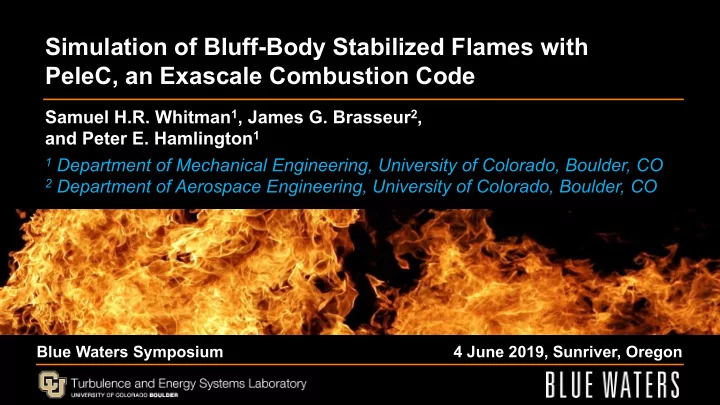

Simulation of Bluff-Body Stabilized Flames with PeleC, an Exascale Combustion Code Samuel H.R. Whitman 1 , James G. Brasseur 2 , and Peter E. Hamlington 1 1 Department of Mechanical Engineering, University of Colorado, Boulder, CO 2 Department of Aerospace Engineering, University of Colorado, Boulder, CO Blue Waters Symposium 4 June 2019, Sunriver, Oregon
Problem Overview In many high-speed systems, maintaining stable combustion is a challenge Campbell & Chambers (1994) 1
Problem Overview In many high-speed systems, maintaining stable combustion is a challenge We can use the flow dynamics of recirculation zones for stabilization Campbell & Chambers (1994) 1
Problem Overview In many high-speed systems, maintaining stable combustion is a challenge We can use the flow dynamics of recirculation zones for stabilization Accurately capturing the physics of these zones with low-resolution codes is an ongoing challenge Campbell & Chambers (1994) 1
Problem Overview In many high-speed systems, maintaining stable combustion is a challenge We can use the flow dynamics of recirculation zones for stabilization Accurately capturing the physics of these zones with low-resolution codes is an ongoing challenge We use Blue Waters to perform high- resolution simulations Campbell & Chambers (1994) 1
Turbulent Combustion Dynamics Shanbhogue, Husain, Lieuwen (PECS, 2009) 2
The Air Force Research Laboratory Case Paxton et al. (AIAA, 2019) n Flame stabilization by bluff bodies goes back to the first half of the 20 th century n The AFRL experiments are currently ongoing n Matching computational and experimental results remains a challenge 3
Problem Overview: The AFRL Case Where can simulations realistically n compare against experimental data? A common computational shortcut is n to use a smaller spanwise domain with periodic boundary conditions in that direction There is very little in the literature on n aspect ratio and spanwise boundary effects for these cases Methane flame stabilized on a circular rod, Zukoski (1954) 4
PeleC Exascale Combustion Code § Developed at LBNL, NREL, and ANL for performance on current and future supercomputers § Direct Numerical Simulations (DNS) of turbulence- chemistry interactions in conditions relevant to practical combustion devices § Embedded Boundary (EB) capability for modeling device structure § Adaptive Mesh Refinement (AMR) built on the AMReX framework (https://amrex-codes.github.io) 5
PeleC: Built on AMReX Block-Structured AMR § Increase efficiency by focusing on dynamically important regions § For the cold flow we refine on cut cells (the bluff body) and vorticity magnitude. § For reacting cases we are currently also refining on intermediate species § We see orders of magnitude speedup over static refinement (https://amrex-codes.github.io) 6
Non-Reacting Convergence: Intent: Cases: Aspect Ratio § Study effects of AMR on convergence of bluff-body flow 1 2 4 simulation: “how much refinement do we need?” 1 X Levels of AMR § Understand effects of varying 2 X X X aspect ratio: “how wide a domain do we need?” 3 X X X 4 X X 7
Non-Reacting Convergence: Computational Cost: Cases: Aspect Ratio § Cheapest: run on 4 nodes, ~100 1 2 4 node-hours 1 X Levels of AMR § Most expensive: run on 80 nodes, ~20,000 node-hours. 2 X X X § Good weak scaling in this range on Blue Waters. 3 X X X § Scaling is limited by AMR 4 X X refinement level and criteria 8
AMR In Action 9
Increasing AMR Levels and Local Resolution 1 AMR Level 2 AMR Levels 11
Increasing AMR Levels and Local Resolution 3 AMR Levels 4 AMR Levels 12
Time-Averaged Velocity Fields 13
AMR Resolution and Convergence: X-Velocity Statistics § X-velocity normalized by inflow bulk velocity 𝑉 " § Aspect ratio of 2 § Plots show: § PDF from recirculation zone § Mean x-velocity § Standard deviation § Skewness 14
Aspect Ratio Comparison AR 1 AR 2 AR 4 15
Aspect Ratio: X-Velocity Statistics § X-velocity normalized by inflow bulk velocity 𝑉 " § 3 AMR levels § Plots show: § PDF from recirculation zone § Mean x-velocity § Standard deviation § Skewness 14
Work in Progress: Reactions § Isothermal bluff body heated to 600K § Premixed H2-air, inflow at 310K Hot spot is forming and § intermediate species are produced § Combustion has been unstable 15
Summary § AMR is accurately capturing the physics of interest, providing high- resolution simulations at reduced cost compared with static refinement § 3 levels of AMR are resolving the large-scale dynamics relevant to maintaining combustion § Observed differences between full and reduced aspect-ratio domains are minimal § Combustion in simulations with embedded boundaries and AMR is a work in progress and the current focus. 16
Acknowledgements This research is funded by a Blue Waters Graduate Fellowship. This research is part of the Blue Waters sustained-petascale computing project, which is supported by the National Science Foundation (awards OCI-0725070 and ACI-1238993) and the state of Illinois. Blue Waters is a joint effort of the University of Illinois at Urbana-Champaign and its National Center for Supercomputing Applications. 17
Citations Campbell, J.F. and Chambers, J.R., 1994. Patterns in the sky: natural visualization of aircraft flow fields. n Shanbhogue, S.J., Husain, S. and Lieuwen, T., 2009. Lean blowoff of bluff body stabilized flames: Scaling and n dynamics. Progress in Energy and Combustion Science , 35 (1), pp.98-120. Paxton, B.T., Fugger, C.A., Rankin, B.A. and Caswell, A.W., 2019. Development and Characterization of an n Experimental Arrangement for Studying Bluff-Body-Stabilized Turbulent Premixed Propane-Air Flames. In AIAA Scitech 2019 Forum (p. 0118). Zukoski, Edward Edom, 1954. Flame stabilization on bluff bodies at low and intermediate reynolds numbers. PhD n thesis, California Institute of Technology. 18
Questions? 19
Recommend
More recommend